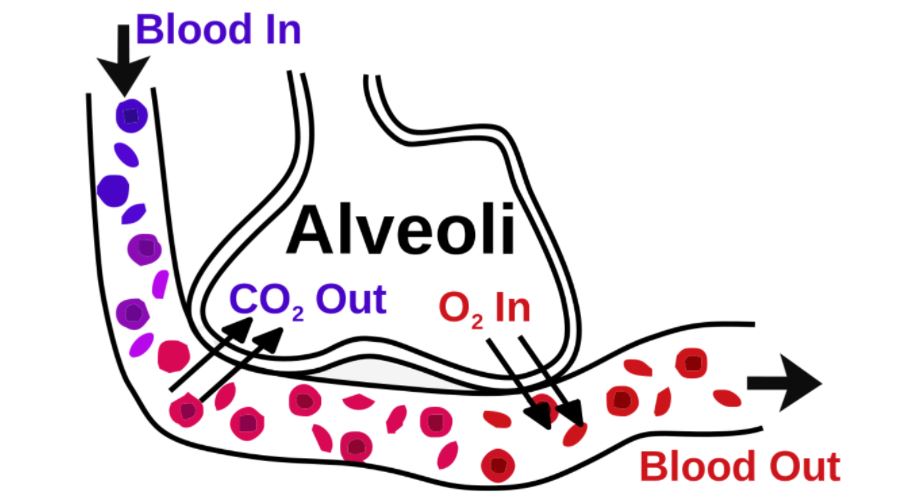 In the past two articles, we have looked at the extraordinary size and function of the horse’s cardiovascular system.
In the past two articles, we have looked at the extraordinary size and function of the horse’s cardiovascular system.
It is one of the most efficient oxygen delivery systems in the animal world and is the prime reason why horses are such gifted athletes.
But a delivery system is only as good as the supply chain. It is the respiratory system that supplies oxygen to the muscles to produce the energy that allows the muscles to move the body.
In this article we will explore the horse's respiratory system and learn why it is the limiting factor in even the highest performing horse athlete.
The horse respiratory system is not as supersized as the cardiovascular system. In terms of weight, the horse's lungs are comparable to humans (1.5% of bodyweight). Horses do have proportionally many more air sacs (alveoli) compared to other mammals (see Figure 1). Alveoli are tiny thin membraned air sacs at the end of larger airways. They are surrounded by numerous tiny blood vessels (capillaries). The delicate complex of air sac and blood vessels are where the all-important exchange of gases occurs and is the source of all the oxygen supplied to the muscles.
Figure 1. Diagram showing how alveoli make up lung tissue at the end of larger airways (left) and close connection between blood supply and each alveoli (right (Artwork by Holly Fischer, CC BY 3.0 <https://creativecommons.org/licenses/by/3.0>, via Wikimedia Commons)
The alveolar/capillary complexes make up 85% of the total lung volume. This is where the oxygen from the air breathed in by the horse moves into the blood and the waste products of metabolism such as carbon dioxide moves out of the blood, into the alveoli and leaves the horse’s body with each breath out.
The gas molecules have to each pass through the membranes of the alveoli and the capillaries. Surface area is important so there is enough space for gas exchange to take place. The equine alveolar surface area (i.e., the contact area for gas molecules to exchange) is approximately 2500m2 (about the area of ten doubles tennis courts) and the capillary surface area contacting the alveolar membrane is about 1700cm2. That is a lot of surface area!
Figure 2. Close up of gas exchange occurring at alveoli/capillary interface. (Artwork attributed to: helix84, CC BY-SA 3.0 <http://creativecommons.org/licenses/by-sa/3.0/>, via Wikimedia Commons)
Uploading and downloading gas molecules occurs through the membranes shown as black lines in Figure 2. The gas molecules literally pass through the membranes of the cells lining the alveoli and the capillaries. This happens through a process called diffusion. Diffusion is physical process that does not require any metabolic effort by the horse. The rate of diffusion does not change with exercise although it can be influenced by how much of each gas is present, air flow (ventilation), blood flow (blood pressure) and even how much moisture is present in the alveoli. It is the rate of the gas exchange in the lungs that ultimately limits how much aerobic exercise a horse can perform.
Flow rates (how much air is moving in and out of the airway) increase with exercise demand and peak at a rate of around 80 litres per second. Peak flow rate is determined by gait in horses with Standardbreds taking one breath for every two strides. The combination of fast breathing, increased red blood cells released from the spleen, and the huge surface area for gas exchange in the alveoli should be able to match the demand for oxygen by the horse when exercising. However, horses working at racing speeds cannot get enough oxygen into their blood stream to fully meet the demands of their muscles. Why is this?
The main reason for this mismatch is linked to the massive increase in cardiac output that was discussed in the second article of this series. The high cardiac output pushes the blood cells through the capillaries surrounding the alveoli so fast there is simply not enough time for all the available oxygen to diffuse across into the blood stream. Other factors include an incapacity of the pulmonary circulatory system to cope with all the blood coming out of the heart. The pulmonary circulatory system will automatically shunt some blood directly out of the lungs without going close to the alveoli for gas exchange. The high pressures created in the pulmonary vessels by the enormous cardiac output produced by the horse's supersized cardiovascular system also results in some plasma being forced out of capillaries as they run next to the alveoli. This fluid slows down the rate of diffusion by the oxygen even further.
The irony of the equine athlete is that the very adaptation that enables the horse to run very fast over relatively long distances, an enormous cardiovascular system, is also the mechanism that ultimately causes even perfectly healthy horses to fatigue. Any disease process impacting on the respiratory tract, active or historical, can reduce that time to fatigue. In the next article we will explore how this occurs.
>> READ MORE: The athletic horse: cardiovascular system (part one)
>> READ MORE: The athletic horse: cardiovascular system (part two)


